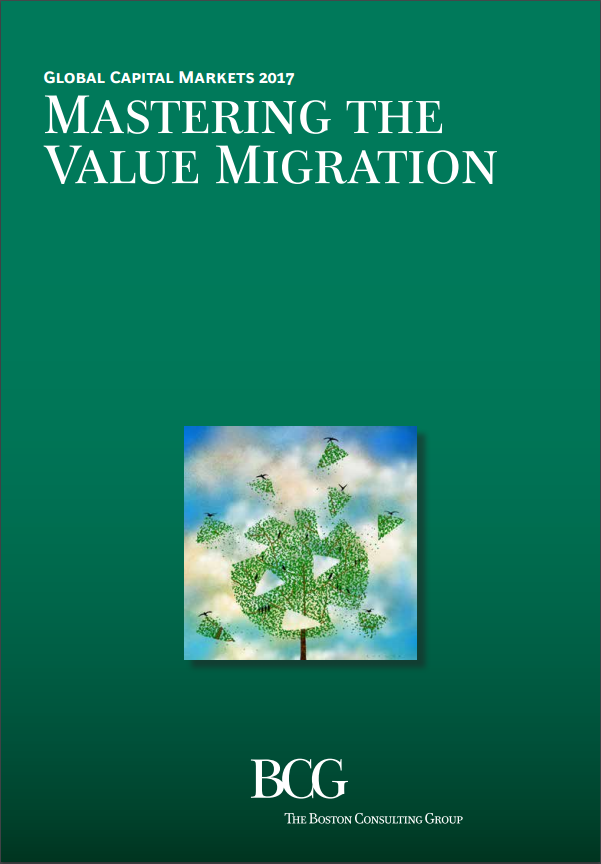BCG Global Asset Management Report 2017
The Innovator’s Advantange
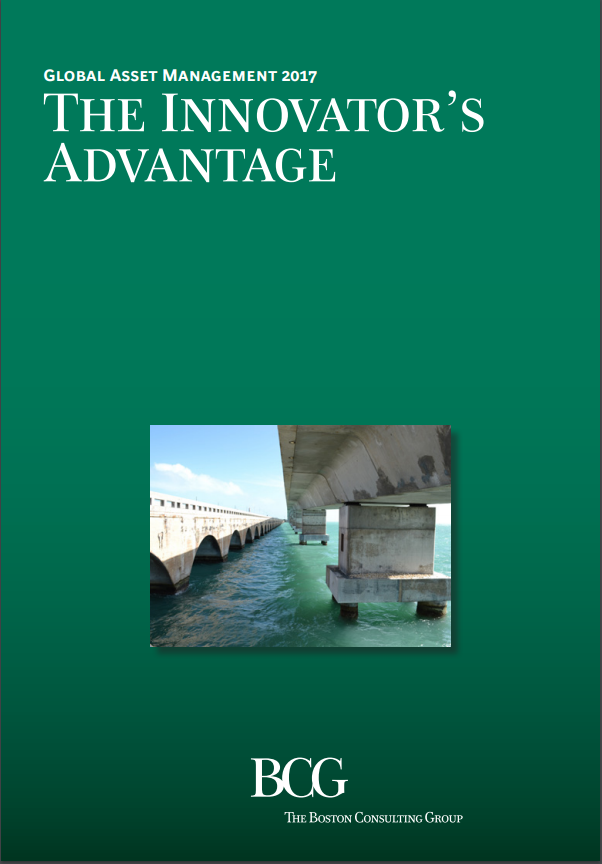 The growing challenges confronting asset management were confirmed by the industry’s global performance in 2016. For the first time since the 2008 financial crisis, the revenue pool of traditional managers fell worldwide, along with their profits. Margins contracted as fee pressures continued to increase.
The growing challenges confronting asset management were confirmed by the industry’s global performance in 2016. For the first time since the 2008 financial crisis, the revenue pool of traditional managers fell worldwide, along with their profits. Margins contracted as fee pressures continued to increase.
Assets under management (AuM) returned to growth, largely thanks to rising asset values on financial markets. Net new flows, the industry’s wellspring of growth, remains tepid and little changed from recent years.
In 2017, the environment remains challenging, with the specter of continued outflows from active products and even esoteric long-only asset classes. Meanwhile, the acceleration of new, disruptive technologies will create opportunities for some asset managers while posing threats to others.
With that in mind, we argue in this report that tomorrow’s industry leaders will appear quite different from today’s. To be among them, asset managers will need to seize opportunities to act boldly and transform the very way they work, through innovation that fully embraces advanced technologies such as artificial intelligence, machine learning, big data, and analytics. This will be especially true in investment management and distribution.
Understanding and pursuing opportunities embedded in big market moves will also define success—whether through M&A, partnerships, or gaining entry to promising new markets, such as China. Finally, acting to address costs structurally will differentiate winning managers, whether they take advantage of automation technology or leverage third-party resources.
Those that succeed in making these changes will consolidate their position. Others will increasingly struggle with disruption and turbulence.
These conclusions are among the central themes of this report, The Boston Consulting Group’s 15th annual study of the global asset management industry. They are the result of market-sizing research, an extensive worldwide benchmarking survey, and insights from our client work and other industry activities.
Like its predecessors, this report opens with a detailed and data-based profile of the industry’s overall state of health. It reviews asset management performance, globally and by region, as well as emerging product and competitive trends. The opening chapter concludes with a discussion of the five sources of the most significant gain for players in the years to come: growth in China, product portfolio management and innovation, business models and mergers and acquisitions (M&A), technology, and cost management.
The second and third chapters of this report assess two topics critical to every asset manager’s future growth. The second chapter explores the benefits of optimizing investment management for the digital age. Investment management stands at the crossroads of success and failure as firms race to enhance investment performance while achieving customer-driven innovation, technological prowess, and heightened operational efficiencies.
The third chapter explores the strategic value—and dangers—of M&A for asset managers. As the industry’s economics become more difficult, M&A activity will likely accelerate. Deals will become bigger and more international, raising the stakes and the challenge of postmerger integration.
As a result, M&A opportunities will abound for firms to acquire the scale, products, expertise, and distribution channels needed to leapfrog to higher levels of prosperity—but so will the dangers of forming a catastrophic “marriage.” We look at how firms can avoid the pitfalls of bad partnering and use M&A to close the gap by adapting one of four business models that offer the potential for sustainable success.
Failure to act decisively—whether in revamping investment management or optimizing M&A opportunities—will especially dim the prospects of asset managers that cling to traditional active assets. The decade-long migration from their legacy products will continue, as it did in 2016.
Traditional active core assets will be squeezed, losing share of revenue and AuM. Alternatives, solutions, and specialties will continue to generate strong fees, while passives will persist in dominating the growth of AuM, if not revenues.
In an environment of uncertain market growth, weak net inflows, and diminishing fees, it will be impossible for all asset managers to thrive. In our view, success will be limited to organizations that earn advantage through innovation and excellence in managing their entire portfolio of businesses. Winning players will include those that fully embrace advances in data and analytics to achieve superior investment performance. They will excel at structuring solutions and invent compelling client service while keeping costs under control.
The benchmarking survey that informed this year’s report involved 153 leading asset managers—representing $43 trillion, or more than 62%, of global AuM—and covered more than 3,000 data points per player. Our measurements covered assets in 43 markets globally, including offshore.
The assessment of investment management included a review of organizational structures for investment, research and trade execution functions, benchmarking of costs and staffing, and deep dives on innovation, customization, and best-practice use of technology and tools.
BCG Global Wealth Report 2017
Transforming the Client Experience
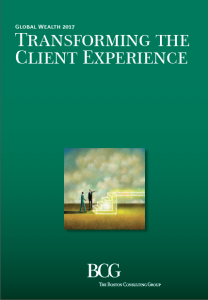
This report, The Boston Consulting Group’s 17th annual analysis of the global wealth management industry, includes two topics that we reexamine every year—the global market-sizing review and the wealth manager benchmarking study—as well as a special chapter about the impact of digital technology on the industry.
The market-sizing chapter outlines the evolution of private wealth from both global and regional perspectives, including viewpoints on different client segments and offshore centers, and takes a fresh look at private-banking revenue pools. The benchmarking analysis stems from a survey of more than 125 wealth managers and involves more than 1,000 performance indicators related to growth, financial performance, operating models, sales excellence, employee efficiency, client segments, products, and trends in different markets.
In our benchmarking, we focused on issues surrounding the decline of what for many years was a highly profitable wealth management business, lightly regulated and with low capital requirements. To be sure, since the financial crisis of 2007–2008, institutions have been dealing with more sophisticated and circumspect investors who demand reduced fees and commissions in order to increase returns in a low-yield world. Wealth managers have tried to reduce costs to ease the squeeze on profit margins, but a more forward-looking approach will be required in the future. On the positive side, we have observed an inflection point over the past year, with more wealth managers beginning to increase strategic investments to transform their businesses.
Our benchmarking chapter also takes a detailed look at the ever-evolving role of the relationship manager and how that critical position is shifting—indeed, how it must shift—in the search for competitive advantage. Overall, it is our view that wealth management, despite considerable challenges, will remain a very attractive business as long as institutions take steps to adapt to the changing environment. Determining investment priorities and following through on them will be critical to success.
In our discussion of digital technology, we highlight how digital has become a key accelerator for future change in wealth management. The problem is that most players, so far, have pursued digital innovation primarily as a feature selection exercise, centering on what their existing technology can provide along with what competitors (and, to some extent, fintechs) may intend to offer. Many of their digital launches have been realized opportunistically, stemming from one-off task forces, thus producing basic, largely disconnected, or insufficiently embedded digital capabilities. In order to make a step change in digital advancement and leapfrog the competition—to truly transform the client experience—wealth managers need to introduce a new approach to client journeys, upgrading to a next-generation, 2.0 version.
In preparing this report, we used traditional segment nomenclature that will be familiar to most wealth management institutions, dividing the client base into the following categories: affluent, lower high net worth (HNW), upper HNW, and ultra-high net worth (UHNW). These wealth bands tend to vary from player to player. We based segments on the following measures of private wealth:
- Affluent: between $250,000 and $1 million
- Lower HNW: between $1 million and $20 million
- Upper HNW: between $20 million and $100 million
- UHNW: Over $100 million
Moreover, in order to clearly gauge the evolution of global private wealth, we have updated and fine-tuned our market-sizing methodology, incorporating newly available data for countries where information previously had been difficult to obtain. The report also introduces our revenue pools model, which can be used to estimate banking market sizes and potential total banking revenue. Our revenue pools methodology calculates market-specific results for the largest 18 markets (covering 80% of total global wealth). Results for the remaining markets are based on regional averages. All growth rates are nominal, with fixed exchange rates.
As always with our annual global wealth reports, our goal is to present a clear and complete portrait of the business, as well as to offer thought-provoking analyses of issues that will affect all types of players as they pursue their growth and profitability ambitions in the years to come. We take a holistic view of the entire wealth management ecosystem, emphasizing how the market, institutions, and clients interact and identifying where the best opportunities for wealth managers can be found.
BCG Global Capital Markets Report 2017
Mastering the Value Migration
The capital markets ecosystem turned in a decent performance in 2016 compared with the previous five years. Although investment banking revenues continued to decline, they did so at a lower rate, while other types of players—such as exchanges and venues, information providers, and buy-side institutions—realized revenue gains. The net result was year-over-year growth of 5% in total industry revenues.
We refer to the shift of global revenue pools from banks to nonbanks as the value migration. This migration has continued along the following paths:
1) From smaller investment banks to large universal banks
2) From players without a specific niche to those with a concentrated focus, such as boutiques specializing in M&A
3) From regulated to unregulated entities
4) From firms with weaker digital capabilities to data- and tech-savvy firms
5) From players without a distinct informational advantage to those with proprietary data and insights
Although a lessening of the effects of quantitative easing, along with impending deregulation, may dampen the impact of the value migration, institutions must still find ways to master it and make it work to their advantage. Several key forces will continue to shape the evolution of the market.
One such force is evolving regulatory dynamics. While some regulatory easing is expected in the US, it is not clear how deep or broad the changes might be. At this stage, the only certainty is continued uncertainty, which may make it increasingly difficult for banks to carry out strategic planning. Moreover, while banks may benefit from regulatory relief, the US financial regulatory framework will, overall, continue to provide advantages to nonbank competitors.
In Europe, regulatory trends are likely to follow suit. Initiatives such as the updated Markets in Financial Instruments Directive (MiFID II) and the Markets in Financial Instruments Regulation (MiFIR) will open the door to greater transparency, shift trading to more centralized marketplaces, and develop more explicit pricing for trading and investing.
Another driver of the industry’s transformation is the increasingly tight link between value creation and data and technology. To investigate this point further, BCG looked at total shareholder return for a sample of publicly traded firms in the industry. Our analysis determined that exchanges and venues, along with information providers, have led value creation in the post-crisis era, a finding consistent with the value migration trend. Moreover, we saw that top-performing firms come from every part of the ecosystem—pure-play investment banks, buy-side institutions, exchanges and venues, and information providers—and share a number of common traits. Crucial among these is a commitment to leveraging technology for more digitally innovative ways of doing business.
The implications of this trend vary by player type. For an investment bank, for example, a key challenge is to move beyond traditional ways of leveraging data to drive value. Greater emphasis should be placed on using cutting-edge technologies to provide a more holistic view of the client and facilitate a more customer-centric approach to client service. Similarly, banks must move beyond providing research and advisory services on the basis of a so-called soft-dollar commission model and toward developing platforms that can be monetized either directly or indirectly.
One recent manifestation of technology-driven value migration and regulatory arbitrage is the rise of principal trading firms across electronically traded asset classes. These players are capturing significant share from traditional market participants in trading activities. They are also seeking to expand into new asset classes and to diversify beyond pure market making into areas such as customer business (with the support of prime brokers), risk management analytics, and liquidity outsourcing to other intermediaries, all of which puts further pressure on the traditional “supermarket” model of banking.
Given rapid market evolution, ecosystem players — especially banks — must also continue to push for digital transformation of their businesses. Successful digital innovation requires a comprehensive reevaluation of people and incentives, organizational structure, processes, and operations. The road can be rocky, but if navigated skillfully, it can result in a leaner and more adaptive organization that is better able to seize the opportunities provided by continued market change.
BCG/Expand Whitepapers
Fintech in Capital Markets – A Land of Opportunity
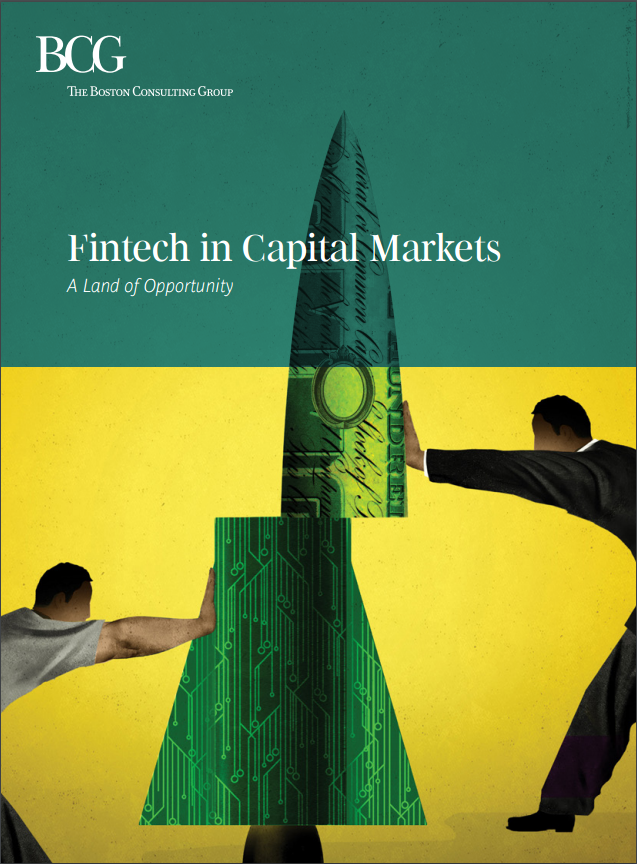
Indeed, fintech is introducing new paradigms that CM players can exploit to their advantage in a landscape that is complex and difficult to navigate.
Yet time is of the essence. Banks and the entire capital markets ecosystem must take action now in order to gain the considerable benefits available. Without aggressively establishing industry consensus and standards or simplifying IT architecture, incumbents may find themselves left behind by the changing market structure brought about by these new entrants.
BCG Global Capital Markets Report 2016
The Value Migration

Yet the same cannot be said for the capital markets industry as a whole—the ecosystem that includes buy-side firms, sell-side firms, information service providers, and exchanges. Indeed, even as regulation forces investment banks to retrench and hinders their ability to compete, other players remain unaffected and will even, in some cases, benefit. Over the next five years, revenues in the capital markets industry will grow by an estimated 12%, increasing to $661 billion from $593 billion in 2015.
The asset base of buy-side entities is expected to reach around $100 trillion by 2020, up from an estimated $74 trillion in assets under management (AuM) in 2014. If this transpires, the buy side will generate nearly $300 billion in fees by 2020, constituting 45% of the overall capital markets revenue pool (assuming favorable market conditions and current fee structures). However, investment banks, on the sell side, are expected to generate just over $205 billion by 2020, a decrease to 31% of the total revenue pool from 53% in 2006.
Information service providers and exchanges are poised to benefit. They will profit from increased demand for technology solutions and greater access to market information and analytics. Growth in electronic exchange trading and the use of central clearing will mean that their share of the capital markets revenue pool will grow to 19%, representing an estimated $125 billion, by 2020—an impressive rise from 8% in 2006.
Yet even as competition intensifies, opportunities for investment banks will continue to arise. Some larger or niche players will be able to absorb market share from those that are retrenching. Others will require a change in mindset and approach to explore alternative revenue opportunities beyond their traditional roles as capital raisers and market makers. Such players might consider leveraging internal data and technology systems to diversify revenues and enhance their market positions. They should build on their already mature sourcing strategies to push to the next level of operational and process efficiencies.
Moreover, the role of capital itself is changing. Escalating capital costs, occurring simultaneously with the growth of buy-side assets and revenues, indicate that the industry is moving toward leveraging benchmarks and other index products aimed at passive investors. Both the ability to discover liquidity and the demand for risk transformation services are becoming less dependent on capital. If investment banks are to compete, they must recognize their ability to generate revenues as information companies.
Ultimately, investment banks will need to be the right size, develop the right model, and take the right approach to return to consistent profitability. Dealers must learn to compete within the critical sectors of the new capital-markets ecosystem—data and financial technology. How they fit themselves into increasingly electronic, standardized, and transparent markets will be crucial. They are losing the battle so far, but that does not mean they will lose the war.
This report, BCG’s fifth annual study of the global investment banking business, emphasizes the challenges that investment banks face and examines the consequences of new and diverse players in the overall capital markets ecosystem invading their territory. Traditional revenue streams are migrating to these entities, and it is still unknown whether—or when—this trend will reverse. Either way, the investment banking industry has entered a highly dynamic, largely unpredictable era. It is time for players of all stripes to assess their current strengths and weaknesses and to plan for the future.
BCG Global Capital Markets Report 2015
Adapting to Digital Advances
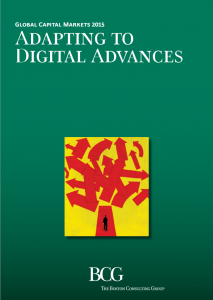
Long periods of low volatility have been interrupted by extreme spikes, with issuers flooding the primary market and dealers pulling out of capital-intensive businesses such as fixed income, currencies, and commodities (FICC) when the cost of warehousing assets became prohibitive. Negative interest rates in some European countries means that banks will struggle to maintain a positive overall net interest margin. This development, combined with other punitive capital requirements, has made it very difficult for banks to be in the risk capital business. Indeed, many are turning away.
For the institutions that remain, of course, reduced capacity should provide an opportunity to boost market share—but the challenging environment in 2014 prevented most from making any significant gains. Indeed, a bigger buy side (although itself under increased pressure from regulators) demands margin reduction in a world increasingly characterized by electronic trading, while higher capital costs and the need for more technology investment are impairing profitability. Banks have seemingly reached an impasse of sorts, with the industry’s cost-to-income ratio (CIR) stubbornly remaining above 70 percent, albeit with wide variation depending on the specific business model. The industry gloom that we have been forecasting for some time is now well and truly upon us.
This year’s report, our fourth annual study of the global CMIB business, emphasizes the digital domain. Our aim is to provide food for thought for senior management teams as they look to transform their organizations into lean, digitally fit, client-centric institutions.
BCG Global Capital Markets Report 2014
The Quest for Revenue Growth

Although the industry-wide revenue decline in 2013 was not dramatic, at about 2 percent, the largest revenue pool—fixed income, currencies, and commodities (FICC)—suffered a steep drop of 16 percent. This decline was offset to some degree by substantial rises in equity and investment banking division (IBD) revenues. But after-tax return on equity (ROE) remains under pressure, falling slightly in 2013 to 11 percent, with further declines probable in 2014.
Overall, we believe that the industry’s focus on regulatory compliance and cost reduction, necessary as those activities may be, has worked somewhat against placing sufficient emphasis on improving core business capabilities and increasing revenues. As for regulation, the framework for the future has largely been set. It is the implementation of this structure that still has a long way to go—and that continues to generate uncertainty regarding both revenue models and costs.
With the outlook for revenue growth so dim, the industry winners will be those institutions that are able to increase market share. Several factors will be key to this battle. First, client centricity continues to be critical as a way to make relationships more comprehensive, more durable, and more fruitful both for the client and the bank. Second, CMIB institutions need to define what the investment banker of the future looks like—and to make sure they can attract the best and brightest. Such individuals will need a broad set of skills, an entrepreneurial and innovative spirit, and the ability to embrace a deep cultural sense of compliance and collaboration. Third, CMIB players need to investigate commercial partnerships in order to mitigate the revenue effects of retrenchment in certain regions and products.
In our 2013 report, Survival of the Fittest, we asked whether the CMIB industry could survive in the long term. Our answer then, as it is today, is yes, but tall challenges remain. In this, our third annual report on the global CMIB business, we take a deeper look at those challenges, particularly regarding the core dynamics—revenues, regulations, clients, people, and partnerships—that influence the six business models that we feel are most viable. Our aim is to provide food for thought for senior management teams as they refine their strategies.
BCG Global Capital Markets Report 2013
Survival of the Fittest
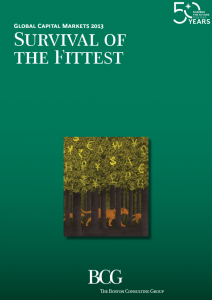
Indeed, after-tax ROE levels of 15 to 20 percent appear to be a thing of the past for most players. The industry average was in the 10 to 13 percent range at the end of 2012, and we estimate that a further 3 percentage points of negative impact from regulation has yet to be absorbed, which will push current ROE levels down to the 7 to 10 percent range.
This situation poses a fundamental question, one that is currently being debated in the market: with other financial-services sectors yielding higher ROE, is the CMIB industry likely to find enough support from impatient investors and boards of directors to survive in the long term? The answer is yes, but with caveats.
Overall, we believe that the central role of CMIB institutions in the global economy remains intact. Corporations and governments still need to raise capital for investments, investors still need to find adequate returns, and risk still needs to be assessed, intermediated, and transformed.
Yet numerous pressures exist. Some issuers and investors, for example, are attempting to create a marketplace without intermediation. Certain less-regulated entities such as hedge funds and physical-commodity traders are venturing into the traditional CMIB space. On the resource side, the industry is experiencing cost pressures as well as capital constraints. As a result of these and other dynamics, although the market for CMIB services will remain vital, the value that banks capture will continue to shrink. Some players may be forced to exit the industry entirely, and many more will leave certain asset classes or gradually reduce their exposure and investments in unprofitable areas. In brief, only the fittest will survive.
In this, our second annual report on the global CMIB industry, we explore key market developments and their impact on CMIB players, address the different choices that banks face today as seen through both a “client” and a “product” lens, and propose six business models that we perceive as the most advantageous. In their purest form, these models have the potential to generate ROE well above the 12 percent level that many players will struggle to achieve. But we emphasize that significantly higher ROE levels, those that are closer to the performance of other sectors of the financial services industry, will be attainable only by relatively few institutions within each of the six business models.
